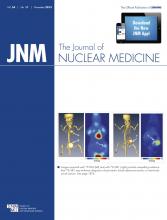REPLY: We thank Adams et al. for their comments on our article (1). Their recent paper cited in their letter provides interesting results about the comparable performance of whole-body MR imaging and 18F-FDG PET/CT for detection of bone marrow involvement in a mixed population of patients with newly diagnosed low-, intermediate-, and high-grade lymphoma (2). We agree with Adams et al. that the potential role of whole-body MR imaging for evaluation of lymphomatous bone marrow involvement in comparison or in association with 18F-FDG PET/CT needs to be further explored.
However, 18F-FDG PET/CT is now a standard procedure for initial staging and response assessment in patients with lymphoma, whereas whole-body MR imaging is still being evaluated for this indication (3,4). Under this current situation, our study was designed to answer a simple pragmatic question: in patients with newly diagnosed diffuse large B-cell lymphoma, is it still worthwhile to systematically perform a masked bone marrow biopsy when 18F-FDG PET/CT, which is routinely performed for initial staging, has the potential to evaluate bone marrow status?
It seems that Khan et al. reached the same conclusions as we do (1,5). 18F-FDG PET/CT provides better diagnostic performance regarding bone marrow involvement when compared with masked unilateral iliac crest bone marrow biopsy. Moreover, bone marrow involvement according to 18F-FDG PET/CT yields a better prognostic stratification since patients with a negative result on bone marrow biopsy and a positive result on 18F-FDG PET/CT for bone marrow involvement have a prognosis similar to that of patients with a positive bone marrow biopsy.
In this setting, the association of whole-body MR imaging with 18F-FDG PET/CT could increase the diagnostic performance of noninvasive bone marrow status, particularly when PET/CT alone shows limited performance, such as in low-grade lymphomas and in diffuse or discordant bone marrow involvement (6). Thus, according to the diagnostic performance of both modalities, and to the lack of radiation exposure from MR imaging when compared with CT, we agree with Adams et al. that PET/MR imaging, despite its slow spread into clinical routine thus far, may evolve as an alternative for staging of lymphoma patients, including bone marrow status.
Footnotes
Published online Sep. 12, 2013.
- © 2013 by the Society of Nuclear Medicine and Molecular Imaging, Inc.







